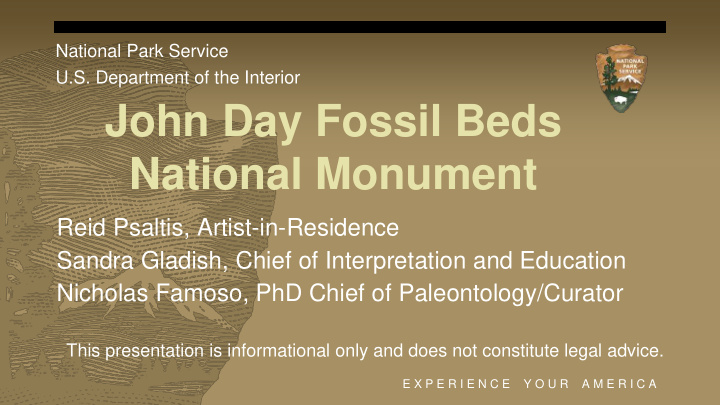



National Park Service U.S. Department of the Interior John Day Fossil Beds National Monument Reid Psaltis, Artist-in-Residence Sandra Gladish, Chief of Interpretation and Education Nicholas Famoso, PhD Chief of Paleontology/Curator This presentation is informational only and does not constitute legal advice. E X P E R I E N C E Y O U R A M E R I C A
Exhibits for All Self-Evaluation Transition Plan (SETP), 2018 ■ Physical Barriers ■ Programmatic Barriers
What is "disability”?
Disability as an Experience
Museums Increase Cultural Capital* *Hayhoe, 2014
Barriers to Inclusion Braden, 2016
Universal Design for Learning Consider physical, intellectual, and psychological needs for all.
Artist-in-Residence (AIR) Art has been part of national park’s history since the 1870s JODA for at least 15 years
Overall Experiences E X P E R I E N C E Y O U R A M E R I C A
Enclosed Fossils Replaced E X P E R I E N C E Y O U R A M E R I C A
Guidance Richard Turner from Oregon Commission for the Blind
Creating a Maquette E X P E R I E N C E Y O U R A M E R I C A
Reconstructing Cynarctoides lemur E X P E R I E N C E Y O U R A M E R I C A
Scientific Review Wang and Tedford, 1999 E X P E R I E N C E Y O U R A M E R I C A
Posing the animal E X P E R I E N C E Y O U R A M E R I C A
Sculpting the body E X P E R I E N C E Y O U R A M E R I C A
Detailing the Fur E X P E R I E N C E Y O U R A M E R I C A
Creating the environment - roots E X P E R I E N C E Y O U R A M E R I C A
Making the mold E X P E R I E N C E Y O U R A M E R I C A
Creating the environment - sand E X P E R I E N C E Y O U R A M E R I C A
City of Bend Accessibility Advisory Committee ■ May 23, 2019 E X P E R I E N C E Y O U R A M E R I C A
Next Steps ■ Replace enamel with cast bronze ■ Have permanent panel with braille ■ Replace drawers with ADA handles ■ Audio Description of specific exhibit
Call to Action Sculpture by Robin Jackson, AIR Sculpture installation by Reid Psaltis, AIR
Thank You’s Reid Psaltis, AIR
References ■ American Alliance of Museums. (2016). American Alliance of Museums 2016-2020 Strategic Plan. Retrieved from https://www.aam- us.org/wp-content/uploads/2017/11/english-stratplan.pdf ■ American Alliance of Museums. (2017). Museum Facts. Retrieved from http://ww2.aamus.org/docs/default-source/museums- advocacy-day/museum-facts-2017.pdf?sfvrsn=2 ■ Bell, F. (2012). How Are Museums Supported Financially in the U.S.? Embassy of the United States of America, Department of State Bureau of International Information Programs. Retrieved from https://photos.state.gov/libraries/amgov/133183/english/P_You_Asked_How_Are _Museums_Supported_Financially.pdf ■ Braden, C. (2016). Welcoming All Visitors: Museums, Accessibility, and Visitors with Disabilities . University of Michigan . 12, 1-14. Retrieved from http://ummsp.rackham.umich.edu/wp-content/uploads/2016/10/Braden-working-paperFINAL-pdf.pdf ■ Buyurgan, S. (2009). The Expectations of the Visually Impaired University Students from Museums. Educational Sciences: Theory and Practice, 9(3), 1191-1204. https://files.eric.ed.gov/fulltext/EJ858923.pdf ■ Clintberg, M. (2014). Where Publics May Touch: Stimulating Sensory Access at the National Gallery of Canada. The Senses and Society , 9(3), 310 – 322. ■ Hayhoe, S. (2013). Expanding Our Vision of Museum Education and Perception: An Analysis of Three Case Studies of Independent Blind Arts Learners. Harvard Educational Review, 83(1), 67-86. https://doi.org/10.17763/haer.83.1.48170l3472530554 ■ Hayhoe, S. (2014). An enquiry into passive and active exclusion from sensory aesthetics in museums and on the Web: two case studies of final year students at California school for the blind studying art works through galleries and on the web. British Journal of Visual Impairments, 32(1), 44 – 58. https://doi.org/10.1177/0264619613514238 ■ Levent, N., Pursley, J., & Wapner, J. (2012). Museum Studies Programs and the Need for Training in Disability and Inclusion: A Project Access White Paper. Art Beyond Sight. Retrieved from http://www.artbeyondsight.org/mei/wpcontent/uploads/WPmus.study_.REVISED.pdf
References ■ Kinsella, E. (2019, January 29). More Than 75 New York Galleries Are Slammed With Lawsuits for Allegedly Violating the Americans With Disabilities Act. Art Net News . Retrieved from https://news.artnet.com/art-world/dozens-of-new-york-galleriesslammed-with- lawsuits-for-ada-compliance-on-websites-1450276 ■ Kudlick, C. (2005). The Local History Museum, So Near and Yet So Far. Public Historian , 27(2), 75 – 81. https://doi:10.1525/tph.2005.27.2.75 ■ Neach, L. (2017). Connecting Universal Design for Learning with Gallery Tours in Art Museum Education (Master’s thesis). Retrieved from https://files.eric.ed.gov/fulltext/ED574834.pdf ■ Rappolt-Schlichtmann, G., & Daley, S. (2013). Providing Access to Engagement in Learning: The Potential of Universal Design for Learning in Museum Design. Curator: The Museum Journal. 56(3), 307-321. https://doi.org/10.1111/cura.12030 ■ Reich, C., Price, J., Rubin, E., & Steiner, M. (2010). Inclusion, Disabilities, and Informal Science Learning. Center for Advancement of Informal Science Education. Washington, D.C. Retrieved from http://www.informalscience.org/sites/default/files/InclusionDisabilitiesandInformalScien ceEducation.pdf ■ Smithsonian Institution. (2001). Art Museums and the Public. Smithsonian Institution Office of Policy & Analysis . Washington, D.C. Retrieved from https://www.si.edu/Content/opanda/docs/Rpts2001/01.10.ArtPublic.Final.pdf ■ Snyder, J. (2005). Audio description: The visual made verbal. International Congress Series, 1282 , 935 – 939. https://doiorg.proxy2.library.illinois.edu/10.1016/j.ics.2005.05.215 ■ Walker, B., Kim, J.,& Pendse A. (2007). Musical soundscapes for an accessible aquarium: Bringing dynamic exhibits to the visually impaired. Conference: Proceedings of the International Computer Music Conference , 268-275. https://doi10.1.1.224.7055
Recommend
More recommend